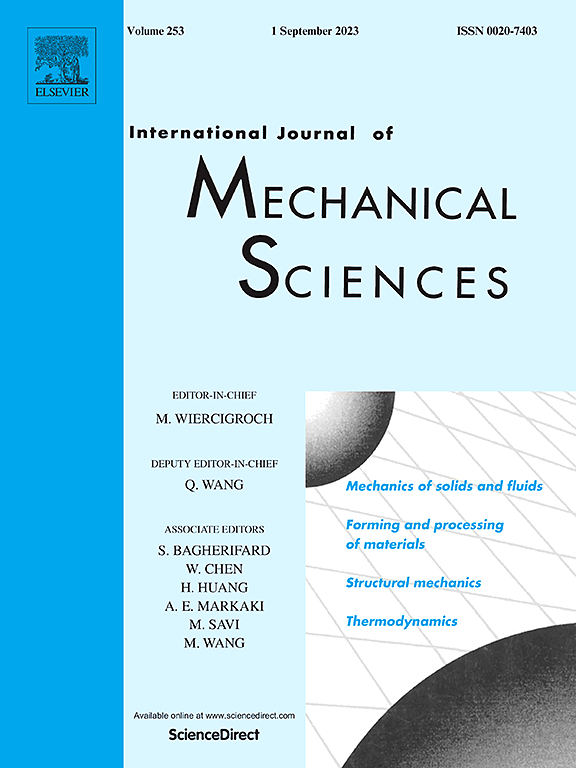Out-of-plane vibration analysis of circular curved beam with attachments
IF 7.1
1区 工程技术
Q1 ENGINEERING, MECHANICAL
International Journal of Mechanical Sciences
Pub Date : 2025-06-22
DOI:10.1016/j.ijmecsci.2025.110508
引用次数: 0
Abstract
Generalized functions are widely used in structural mechanics to address discontinuities in beam-like structures. However, for circular curved beams, bending torsion coupling and intrinsic curvature often prevent the modal functions from being expressed as simple linear combinations of standard trigonometric and hyperbolic functions. This limitation restricts the applicability of the generalized function method to vibration analysis of circular curved beams. This paper presents an analytical solution for the out-of-plane free and forced vibrations of circular curved beams with various attachments under arbitrary boundary conditions. These discrete attachments include translational dampers, torsional-rotational dampers, bending-rotational dampers and attached masses. By successfully utilizing generalized function theory to address discontinuities in response variables of circular curved beam, the proposed method overcomes the limitations of traditional methods, such as beam segmentation, Green’s functions, and Lagrange multipliers. This study provides exact closed-form expressions for natural frequencies, mode shapes, and frequency response functions (FRFs) through a simple process. Furthermore, regardless of the number of attachments, the characteristic matrices remain 6 × 6 in size, offering significant computational advantages and eliminating the repetitive and complex matrix inversion required by some traditional methods. The accuracy and versatility of the proposed approach are validated by comparison with experimental and theoretical results from the literature and with finite element method (FEM) results developed in this study. Additionally, parametric studies on selected examples reveal the influence of various parameters on the system's dynamic behavior.

带附件圆弯曲梁的面外振动分析
在结构力学中,广义函数被广泛用于解决类梁结构的不连续问题。然而,对于圆形弯曲梁,弯曲扭转耦合和固有曲率往往使模态函数不能表示为标准三角函数和双曲函数的简单线性组合。这限制了广义函数法在圆曲线梁振动分析中的适用性。本文给出了任意边界条件下带各种附件的圆曲线梁的面外自由振动和强迫振动的解析解。这些离散附件包括平移阻尼器、扭转-旋转阻尼器、弯曲-旋转阻尼器和附加质量。该方法成功地利用广义函数理论解决了圆形弯曲梁响应变量的不连续问题,克服了传统方法如梁分割、格林函数和拉格朗日乘子的局限性。本研究通过一个简单的过程提供了固有频率、模态振型和频响函数(frf)的精确封闭表达式。此外,无论附件的数量如何,特征矩阵的大小都保持在6 × 6,具有显著的计算优势,并且消除了一些传统方法所需要的重复和复杂的矩阵反演。通过与文献中的实验和理论结果以及本研究中开发的有限元方法(FEM)结果的比较,验证了所提出方法的准确性和通用性。此外,对所选实例进行了参数化研究,揭示了各种参数对系统动态行为的影响。
本文章由计算机程序翻译,如有差异,请以英文原文为准。
求助全文
约1分钟内获得全文
求助全文
来源期刊

International Journal of Mechanical Sciences
工程技术-工程:机械
CiteScore
12.80
自引率
17.80%
发文量
769
审稿时长
19 days
期刊介绍:
The International Journal of Mechanical Sciences (IJMS) serves as a global platform for the publication and dissemination of original research that contributes to a deeper scientific understanding of the fundamental disciplines within mechanical, civil, and material engineering.
The primary focus of IJMS is to showcase innovative and ground-breaking work that utilizes analytical and computational modeling techniques, such as Finite Element Method (FEM), Boundary Element Method (BEM), and mesh-free methods, among others. These modeling methods are applied to diverse fields including rigid-body mechanics (e.g., dynamics, vibration, stability), structural mechanics, metal forming, advanced materials (e.g., metals, composites, cellular, smart) behavior and applications, impact mechanics, strain localization, and other nonlinear effects (e.g., large deflections, plasticity, fracture).
Additionally, IJMS covers the realms of fluid mechanics (both external and internal flows), tribology, thermodynamics, and materials processing. These subjects collectively form the core of the journal's content.
In summary, IJMS provides a prestigious platform for researchers to present their original contributions, shedding light on analytical and computational modeling methods in various areas of mechanical engineering, as well as exploring the behavior and application of advanced materials, fluid mechanics, thermodynamics, and materials processing.
 求助内容:
求助内容: 应助结果提醒方式:
应助结果提醒方式:


